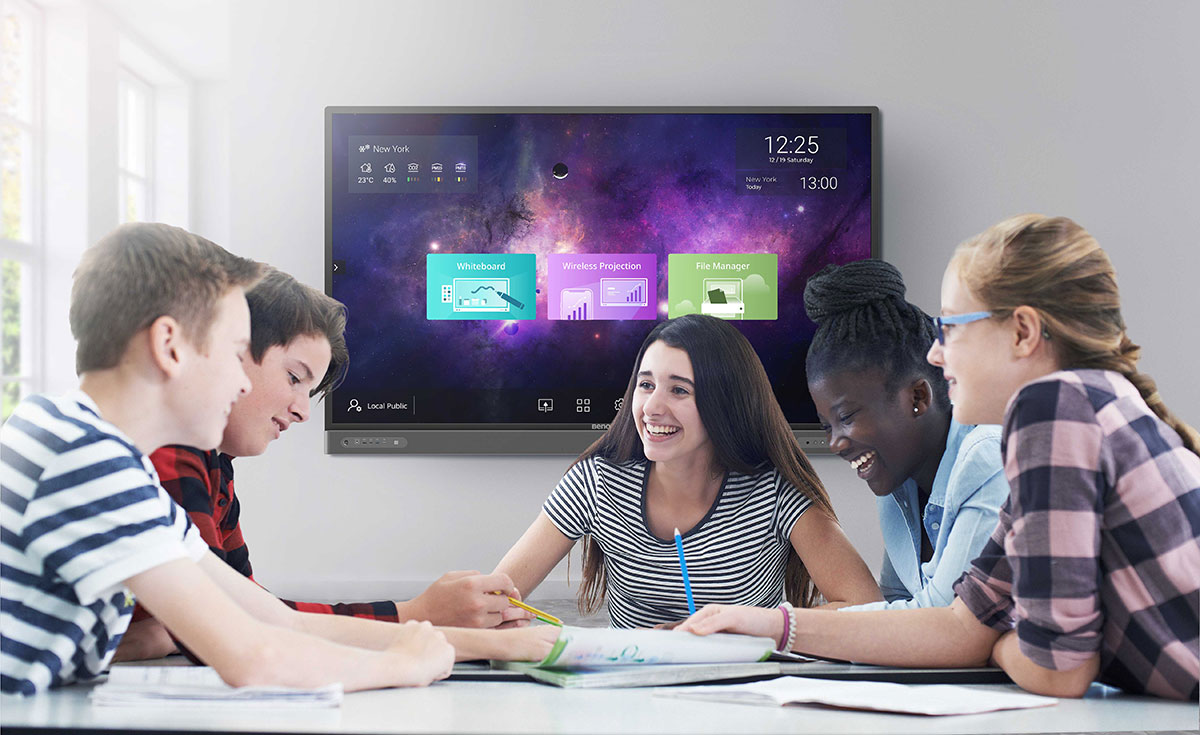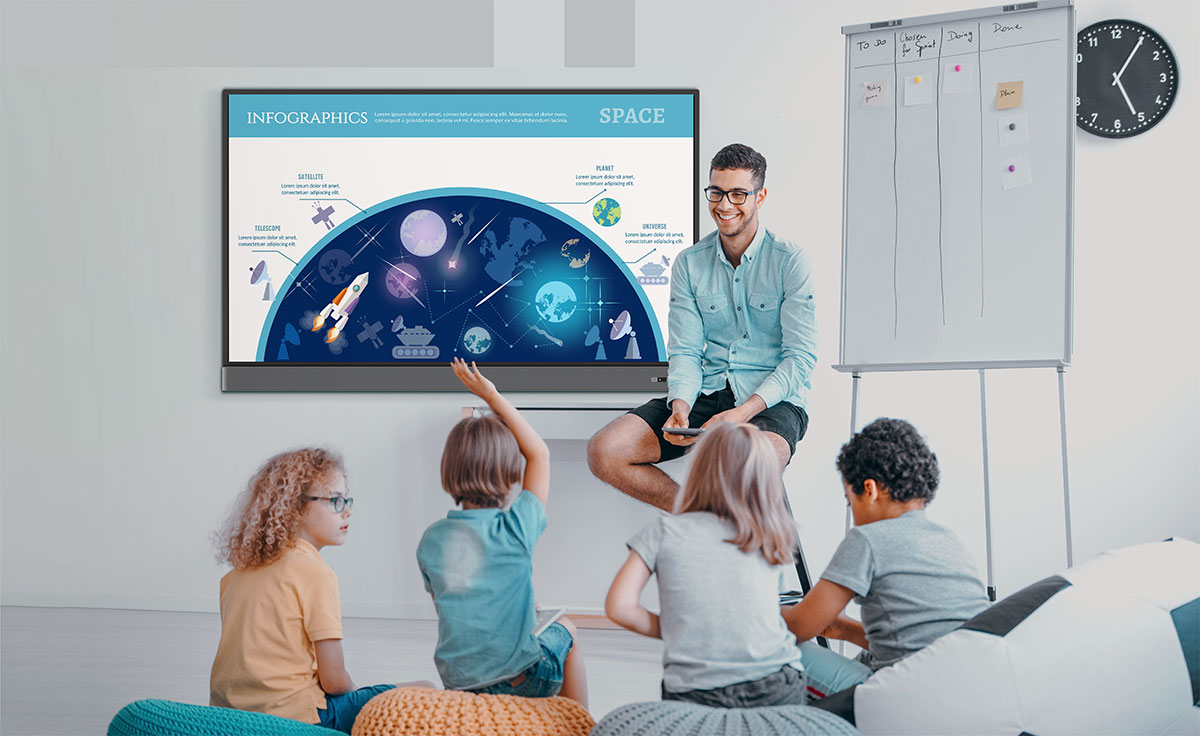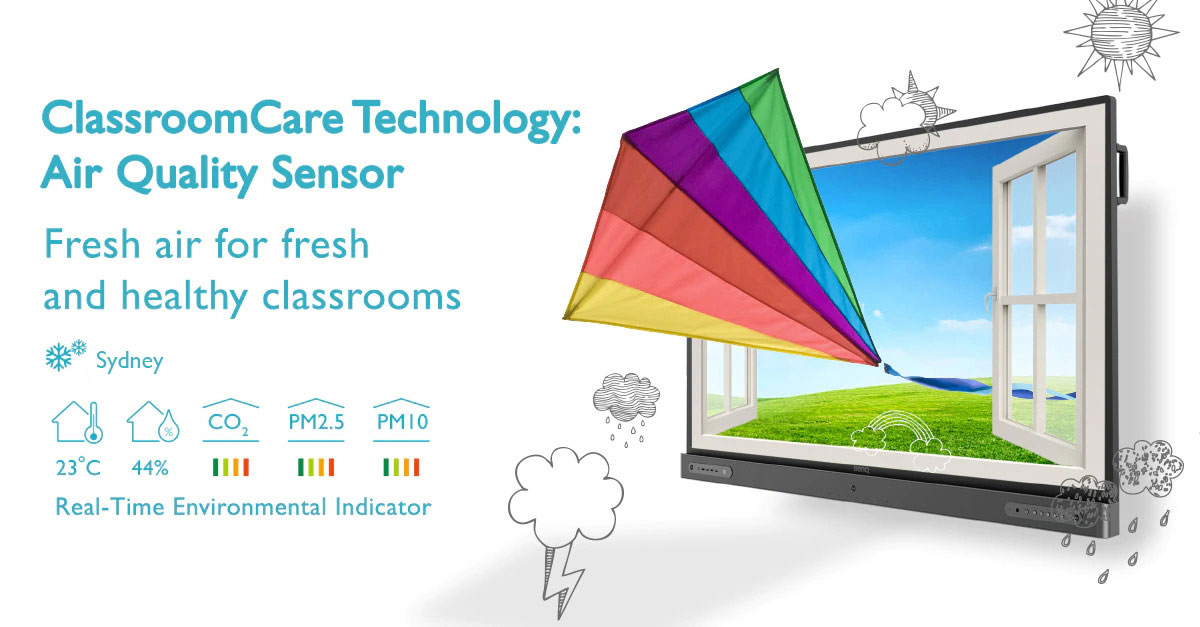Ignorance is bliss but poor air quality is a learning roadblock

Interactive, anti-bacterial touch screens that test air quality, kill most germs, and protect from eyestrain will provide your teachers the peace of mind they deserve post-COVID.
With school health and air quality concerns at an all-time high across Australia, BenQ’s latest interactive boards are a breath of fresh air. They enable your teachers and learners to interact in a classroom space that supports healthy collaboration day-to-day, wall-to-wall, whiteboard-to-whiteboard.
‘Deep breath in, slow breath out…’
Breathing techniques to quieten chaotic classrooms are vital, but not so calming in low-quality air. Just last month, cutting edge research undertaken at UNSW Sydney’s School of Built Environment brought to light the shocking issue of poor air quality in Aussie schools. The research team found that concentrations of carbon dioxide (CO₂) in classrooms peaked significantly higher than the 850-ppm threshold prescribed by the National Construction Code and suggests that enhancing ventilation and environmental quality must be a critical consideration for schools equal to enhancing teaching materials.

As children spend the vast majority of their school days learning inside classroom environments, indoor air quality should be a core concern for schools. In fact, based on government figures, we know that Australian students are couped up in classrooms for at least 25 hours per week, spending more than 1000 hours inside on school property every year. Inadequate air quality can cause pollutants to spike, and microbes to circulate; excessive exposure to pollutants during early development can cause a plethora of respiratory infections, eye irritations, allergies, headaches, and even lifelong issues.
UNESCO has further warned that poor indoor air quality affects student attention and school performance, with worse outcomes in mathematics and reading noted for students exposed to poor indoor air quality. US studies have also noticed that students in classrooms with higher quality ventilation even score 14 to 15 percent higher on standardised tests.
Tracking the quality of the air that your staff and students breathe is how your school can make healthy adjustments to benefit wellbeing. For instance, UNSW Sydney’s study installed a demand-controlled ventilation system to monitor air pollutants in real-time, so they could regulate air quality to meet recommended levels.

‘Sick building syndrome’
Have you heard of it? The term refers to more chronic symptoms people may face due to indoor air pollutants. The Australian Government’s Department of Agriculture, Water and the Environment remarks, “The health impacts of many chemical components in building materials are not well understood”, noting that sick building syndrome could be indicated by shorter term symptoms like skin or eye irritation, headaches and drowsiness, or by longer-term symptoms like respiratory disease. The latter would follow periodic exposure to chemicals that have historically been used in school construction materials, like formaldehyde.
Here in Australia, new school buildings must be designed to comply with the National Construction Code, ensuring both natural and mechanical air ventilation but there is confusion around how schools should regulate air quality. Existing, older buildings have more leeway regarding the Standard but should always be risk assessed and managed as best as possible. RMIT University researchers analysed 10 classrooms around Victoria an found that 80% recorded ventilation rates below the national requirement, and noted that while schools comply with specifications, teacher preferences often dictate the ambiance in a classroom. As a result, unless teachers can effectively monitor air quality, they cannot effectively reduce risk.
Passionate about empowering teachers to improve classroom air quality, BenQ’s ground-breaking new smart interactive display screens have stellar Air Quality Sensors. These help schools measure and display key environmental parameters in classrooms, such as temperature, humidity, PM2.5, PM10, CO2 and Volatile Organic Compound (VOC) concentration levels. With these screens installed, schools have more power to intervene with appropriate adjustments that will benefit teachers and students alike.
Collaborate in clean air with ClassroomCare®

BenQ education interactive flat panel displays are further empowered by a multilayer coating of the non-toxic, nano ionic silver agent to kill most germs that accumulate on touch screen surfaces, preventing cross-infection or epidemic in classrooms. With longer-lasting antibacterial properties than any conventional germ-resistant screen or spray on the market, these screens are a no-brainer in the business of promoting healthy development.
BenQ RP02 education interactive flat panel display provides a comfort and cleanliness level unheard of, until now, for Aussie teachers. The new smart display not only boasts a proven germ-resistant screen, but the friendliest digital whiteboarding and collaboration tools around. With EZWrite cloud whiteboard, wireless screen mirroring and casting app InstaShare, blended STEAM learning has never been more seamless as schools create healthy, collaborative classroom learning experiences.
Built using BenQ’s unique ClassroomCare® technologies, BenQ’s interactive smart boards cover everything from eye care and germ resistance to CO2, temperature, and humidity monitoring, creating safe and healthy spaces for students and teachers.
To find out more about BenQ Interactive Flat Panel, head over to BenQ.com.au.

